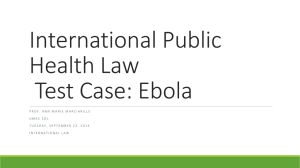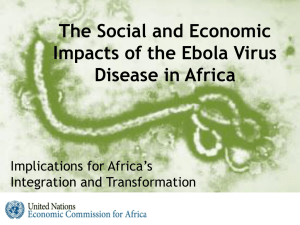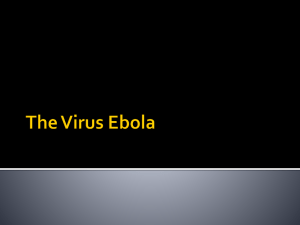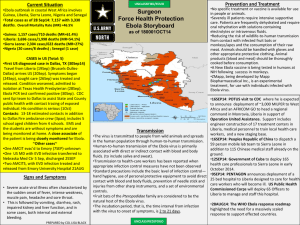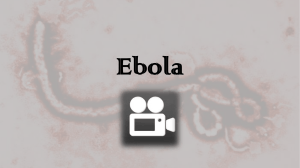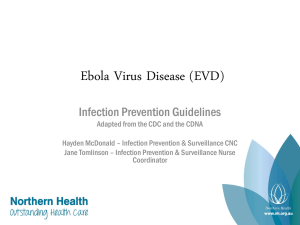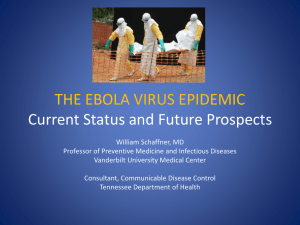2014 Ebola Training PowerPoint for EMS
advertisement
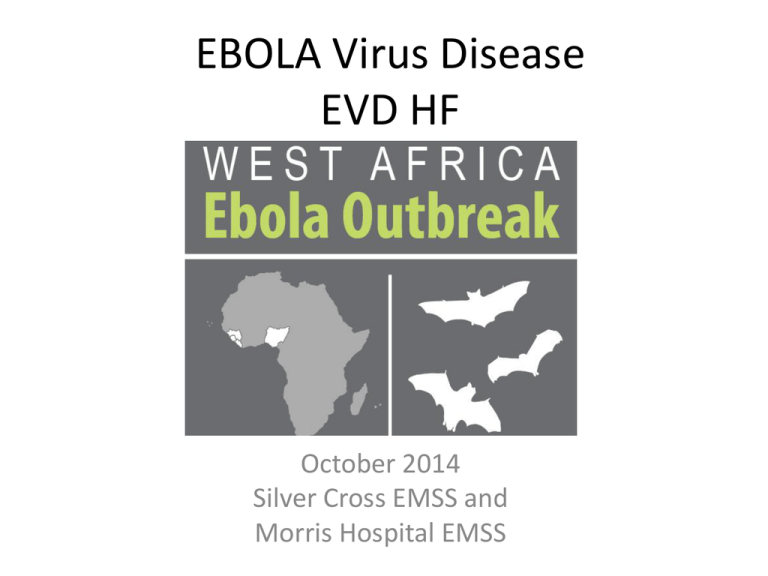
EBOLA Virus Disease EVD HF October 2014 Silver Cross EMSS and Morris Hospital EMSS Interim Guidance for Emergency Medical Services (EMS) Systems • “EMS personnel” means pre-hospital EMS, law enforcement and fire service first responders. • The following EMS personnel practices are based on the most up-to-date Ebola clinical recommendations and information from appropriate public health authorities and EMS medical direction. • Further information will be provided if/when the rules change… What is Ebola Virus Disease (EVD or EVD HF)? • Ebola virus disease (also known as Ebola hemorrhagic fever) is a severe, often-fatal (90%) disease caused by infection with a species of Ebola virus. • The first Ebola virus species was discovered in 1976 in what is now the Democratic Republic of the Congo near the Ebola River. • Since then, outbreaks have appeared sporadically. Ebola Outbreaks 1976-2014 Transmission • Close contact with an infected person. • Ebola is spread through direct contact with: blood or body fluids (such as saliva, sweat, feces, semen, stool or urine) of an infected person or animal or through contact with objects that have been contaminated with the blood or other body fluids of an infected person or animal. Symptoms • The incubation period ranges from 2 to 21 days (most commonly 8-10 days) • Early symptoms include sudden fever, chills, and muscle aches. • Nausea, vomiting, chest pain, sore throat, abdominal pain, and diarrhea (often bloody) may follow. • Symptoms become increasingly severe mental confusion, bleeding inside and outside the body, shock, and multi-organ failure. Treatment Standard treatment for EVD HF is still limited to supportive therapy. Experimental drug therapy that has given hope to those infected: Zmapp, Tekmira Vaccines- None Current Situation Total Cases CDC Updated: August 19, 2014 Suspected and Confirmed Case Count: 2240 Suspected Case Deaths: 1229 Laboratory Confirmed Cases: 1383 WHO 18 Aug 2014 Total confirmed, probable, and suspect cases and deaths from Ebola virus disease : Cases: 2473 Deaths: 1350. Key Points • The likelihood of contracting Ebola is extremely low unless a person has direct unprotected contact with the blood or body fluids (like urine, saliva, feces, vomit, sweat, and semen) of a person who is sick with Ebola or direct handling of bats or nonhuman primates from areas with Ebola outbreaks. • When risk of Ebola is elevated in their community, it is important for Dispatchers to question callers about: – Residence in, or travel to, a country where an Ebola outbreak is occurring; – Signs and symptoms of Ebola (such as fever, vomiting, diarrhea); and – Other risk factors, like having touched someone who is sick with Ebola. • Dispatchers should tell EMS personnel this information before they get to the location so they can put on the correct personal protective equipment (PPE) Key Points • EMS staff should check for symptoms and risk factors for Ebola. Staff should notify the receiving healthcare facility in advance when they are bringing a patient with suspected Ebola, so that proper infection control precautions can be taken. • The likelihood of contracting Ebola is extremely low unless a person has direct unprotected contact with the body fluids of a person (like urine, saliva, feces, vomit, sweat, and semen) of a person who is sick with Ebola or direct handling of bats or nonhuman primates from areas with Ebola outbreaks Address scene safety • If Dispatch or Assessments advise that the patient is suspected of having Ebola, EMS personnel should put on PPE appropriate for suspected cases of Ebola before entering the scene. • Keep the patient separated from other persons as much as possible. • Use caution when approaching a patient with Ebola. Illness can cause delirium, with erratic behavior that can place EMS personnel at risk of infection (flailing or staggering) PPE/BSI • Use of standard, contact, and droplet precautions is sufficient for most situations when treating a patient with a suspected case of Ebola as defined above. EMS personnel should wear: – Gloves – Gown (fluid resistant or impermeable) – Eye protection (goggles or face shield that fully covers the front and sides of the eyes/face) – Facemask • Additional PPE might be required in certain situations (e.g., large amounts of blood and body fluids present in the environment), including but not limited to double gloving, disposable shoe covers, and leg coverings. – Do not attempt to decon impervious fabric (bunker gear) – Wear proper coverings and throw the coverings away in a biohazard container to be processed within the rules set out by CDC Pre-hospital resuscitation procedures Endotracheal intubation, open suctioning of airways, and cardiopulmonary resuscitation frequently result in a large amount of body fluids, such as saliva and vomit. Performing these procedures in a less controlled environment (e.g., moving vehicle) increases risk of exposure for EMS personnel During pre-hospital resuscitation procedures • Endotracheal intubation, suctioning of airways, cardiopulmonary resuscitation: – In addition to recommended PPE, respiratory protection that is at least as protective as a NIOSH-certified fit-tested N95 filtering facepiece respirator should be worn (instead of a facemask). • Additional PPE must be considered for these situations due to the potential increased risk for contact with blood and body fluids including, but not limited to, double gloving, fluid impervious gowns, disposable shoe covers, and leg coverings. Environmental infection control Ambulance Disinfection • Wear recommended PPE (described above) and consider use of additional barriers (e.g., shoe and leg coverings) if needed. • Wear face protection (facemask with goggles or face shield) when performing tasks such as liquid waste disposal that can generate splashes. • Use an EPA-registered hospital disinfectant with a label claim for one of the non-enveloped viruses (e.g., norovirus, rotavirus, adenovirus, poliovirus) to disinfect environmental surfaces. Disinfectant should be available in spray bottles or as commercially prepared wipes for use during transport. • Spray and wipe clean any surface that becomes potentially contaminated during transport. These surfaces should be immediately sprayed and wiped clean (if using a commercially prepared disinfectant wipe) and the process repeated to limit environmental contamination. • A secondary over-wipe type of cleaning after the initial has fully dried is also an option to achieve maximum coverage During patient assessment and management • All patients should be assessed for accompanying symptoms of Ebola, such as: – Fever of greater than 38.6 degrees Celsius or 101.5 degrees Fahrenheit accompanied by additional symptoms such as severe headache, muscle pain, vomiting, diarrhea, abdominal pain, or unexplained hemorrhage. – If the patient has symptoms of Ebola, also ask the patient about risk factors within the past 3 weeks before the onset of symptoms, including: • Contact with blood or body fluids of a patient known to have or suspected to have Ebola; • Residence in—or travel to— a country where an Ebola outbreak is occurring If Exposed • EMS personnel with exposure to blood, bodily fluids, secretions, or excretions from a patient with suspected or confirmed Ebola should immediately: – Stop working and wash the affected skin surfaces with soap and water. Mucous membranes (e.g., conjunctiva) should be irrigated with a large amount of water or eyewash solution; – Contact occupational health/supervisor for assessment and access to post-exposure management services; and – Receive medical evaluation and follow-up care • Recommendations of the CDC/IDPH include fever monitoring twice daily for 21 days, after the last known exposure. They may continue to work while receiving twice daily fever checks, based upon EMS agency policy and discussion with local, state, and federal public health authorities. Follow correct disposal procedures • Any item transported for disposal that is contaminated or suspected of being contaminated with a Category A infectious substance must be packaged and transported in accordance with the HMR. This includes medical equipment, sharps, linens, and used health care products (such as soiled absorbent pads or dressings, emesis basins/pans, portable toilets, used Personal Protection Equipment [e.g., gowns, masks, gloves, goggles, face shields, respirators, booties] or byproducts of cleaning) contaminated or suspected of being contaminated with a Category A infectious substance. • This does include your pillows and cot mattresses unless they are wrapped in an impervious HM container The sky is not falling……. • Remember: Ebola must be reported to local, state, and federal public health authorities. • Good infection control precautions are known to protect responders as long as you follow the recommendation for use Keeping Up What's New http://www.cdc.gov/vhf/ebola/outbreaks/guinea/index.html August 19, 2014: Interim Guidance for Environmental Infection Control in Hospitals for Ebola Virus August 18, 2014: Sequence for Putting On and Removing Personal Protective Equipment (PPE)[PDF - 2 pages] August 14, 2014: Guidance on Air Medical Transport for Patients with Ebola Virus Disease August 13, 2014: HAN 365: CDC Ebola Update #1 August 12, 2014: What CDC is Doing Environmental Interim Guidance for Environmental Infection Control in Hospitals for Ebola Virus (8/19/14) Use a U.S. Environmental Protection Agency (EPA)-registered hospital disinfectant with a label claim for a non-enveloped virus (e.g., norovirus, rotavirus, adenovirus, poliovirus) to disinfect environmental surfaces in rooms of patients with suspected or confirmed Ebola virus infection. Case Definition Person Under Investigation (PUI) 1) Clinical criteria, which includes fever and additional symptoms such as severe headache, muscle pain, vomiting, diarrhea, abdominal pain, or unexplained hemorrhage; 2) AND Epidemiologic risk factors within the incubation period -contact with blood or other body fluids or human remains of a patient known to have or suspected to have EVD HF - residence or travel in an area where EVD HF transmission is active -direct handling of bats, rodents, or primates from disease-endemic areas. Interim Guidance for Monitoring and Movement of Persons with Ebola Virus Disease Exposure Exposure Level Clinical Presentation Public Health Actions 3 Conditional release: Monitoring by public health authority; twice-daily selfmonitoring for fever; notify public health authority if fever or other symptoms develop 4 Controlled movement: Notification of public health authority; no travel by commercial conveyances (airplane, ship, and train), local travel for asymptomatic individuals (e.g. taxi, bus) should be assessed in consultation with local public health authorities; timely access to appropriate medical care if symptoms develop Additional Information • CDC EOC at 770-488-7100 http://www.cdc.gov/vhf/ebola/hcp/index.html • FDOH / PBC Epidemiology Program 561-671-4184 561-840-4500 afterhours Silver Cross EMSS 815-300-7430 or 815-300-2900


